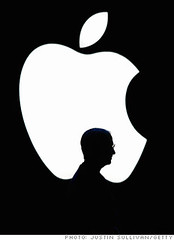Recently, iOS5 — the latest incarnation of the operating system for the iPhone, iPod Touch, and iPad (1 and 2) — was unveiled with much fanfare at the Apple World Wide Developers Conference. At more or less the same time, a small and wholly significant change was made to a section of the developer terms and conditions, a change aimed at ameliorating the furor that erupted when Apple first announced how they saw subscriptions working within the Apple ecosystem. Somewhat predictably, the internet is again awash with various opinions about what the new words may or may not mean and who won and just how evil the various protagonists may or may not be. Before going there, let’s take a step back and see if we can set the latest developments in the context of the overall evolution of the iDevices.
The Early Evolution of the iPhone (2005 – 2008)
September 2005: Apple and Motorola launch the ROKR E1, a phone whose horrible name is magnificently eclipsed by its appalling implementation of iTunes (100 song capacity, and it’s slooow). Designed by committee, in short it’s a disaster.
Fall 2005 – December 2006: Steve Jobs and 200 Apple engineers are at work on the iPhone.
January 9, 2007: Steve Jobs announces the launch of the iPhone
January 11, 2007: In response to many questions about where iPhone users will go to get applications, Steve Jobs is somewhat reticent, citing security issues and saying “You don’t want your phone to be an open platform.” The Internet isn’t much impressed with this approach.
June 6, 2007: Steve Jobs announces that third-party apps can be developed for the iPhone using (drum roll, please) Safari. Yes, apps will best be developed for the iPhone via the browser.
June 29, 2007: The iPhone launches.
July 10, 2007: Just 12 days later, the first “jailbreak” for the iPhone appears, allowing brave iPhone users to create or download ‘proper’ native applications for the device.
August 6, 2007: The first game is made available for the owner of a jailbroken iPhone to download.
October 2007: Steve Jobs announces in a blog post (not the usual “keynote razamatazz, keep the Internet guessing” approach) that a software development kit (SDK) will be made available in March 2008.
March 2008: Users of jailbroken iPhones can download an application called Cydia that easily lets them install native applications (it’s effectively an app store). The iPhone SDK launches.
July 2008: The App Store launches.
Further Evolution of the Ecosystem (2008 – )
Since the launch of the App Store, Apple has been releasing minor and major updates to the mobile operating system as well as announcing further phone-based hardware, and, of course, the “magical and revolutionary device” called the iPad. Apple has also tried, and failed, to get jailbreaking declared illegal via the DMCA act. As the App Store accumulates more apps, stories have emerged of idiosyncratic approval/rejection policies, and indeed some apps have appeared to serve as “inspiration” for future iOS features — apps like this (iBooks anyone?), and these.
Books provided another surprise. In early 2008, Steve Jobs famously announced that, “It doesn’t matter how good or bad the product [Kindle] is, the fact is that people don’t read anymore.” Amazon launches Kindle for the iPhone on March 3, 2009. On March 31, 2010, Apple launches iBooks.
What Can We Conclude So Far?
Apple products “just work” is a principle that transcends all other matters.
Control of the entire infrastructure is everything for Apple.
The platform now known as iOS is not an open one (and it never will be).
It looks very much as though the App Store we know today wasn’t on the original roadmap. Steve Jobs wanted apps to be webapps running in Safari.
It’s not much of a stretch to think that Apple would have planned for new functions and features on the iPhone to come via operating system updates, possibly released in accordance with the phone networks or other major partnerships. Apple makes money from selling hardware, after all. Why build out a massive infrastructure, with all the issues that would need to be solved, if you don’t expect to make much money from the enterprise?
But the take up of the iPhone changed all that. The experience was so good that smartphones went from a niche/workflow/business task oriented product, to mass user/future of the Internet overnight. And Steve Jobs and Apple discovered the truth in William Gibson’s famous quote:
The Street finds its own uses for things — uses the manufacturers never imagined.
Web Apps in 2007 were too advanced a concept for users and businesses getting used to the idea that the Internet on a mobile device could be anything other than an exercise in frustration. Securing the ongoing success of the iPhone and counteracting the threat of the jailbreak community (at one time, some 10% of iPhones had been hacked) seems to have bounced Apple into announcing the App Store. That’s quite a pivot, even for a business like Apple. You can see the evidence for this in the way that the App Store has been jammed into iTunes, and in the way the store is set out. As a retail store front, it’s not very good. As a retail backend, there are significant limits on the number of things that can be sold within an app. The good news for Apple is that despite the costs to run the App Store, they have get a great read on what new functions to incorporate into the next version of the OS, and where to go for their next big partnership/lock-in strategy. Which brings us to February of this year and their announcement about subscription products.
Here’s the first version of the original clause:
Apps can read or play approved content (magazines, newspapers, books, audio, music, video) that is sold outside of the app, for which Apple will not receive any portion of the revenues, provided that the same content is also offered in the app using IAP at the same price or less than it is offered outside the app. This applies to both purchased content and subscriptions.
Now it’s fair to say that these words are open to interpretation. Most interpreted them to mean, “You want to sell stuff via an app, then you must use our system and also pay us (30%). You can’t offer an in app price that compensates for our 30% tithe.” Hulu, Netflix, Spotify, Kindle, Rhapsody — all were at risk of having their iDevice business models go up in smoke if Apple was to actually apply these rules on June 30 and remove infringing apps from the App Store and possibly users devices. EU and US antitrust regulators took an interest, though until the changes actually went into effect, it’s doubtful that any formal investigation would have been launched. However, the EU does have form when it comes to antitrust investigations — just ask Microsoft.
On the June 9, 2011, these words were changed:
Apps can read or play approved content (specifically magazines, newspapers, books, audio, music, and video) that is subscribed to or purchased outside of the app, as long as there is no button or external link in the app to purchase the approved content.
These words are also open to interpretation. What exactly defines a button or external link to purchase approved content? Does “Shop in Kindle Store” count or not? Of course what these words actually mean, is “Whatever the Apple approval process wants them to mean at the time.” The reasons why Apple changed the words are not important; what matters here is the underlying philosophy, which hasn’t changed at all. Having opened up the App Store to secure the ongoing growth of iDevices, Apple needs a way to be able to remove apps that compete with their business interests as those interests evolve.
To date, thinking around iOS has been predicated on the idea that Apple is building an ecosystem that whilst it might be closed, is still available for all paid up players to compete fairly. I think that’s simply not the case. Innovative developments get incorporated into iOS releases. Businesses who show that their products fit into the consumption framework of an iDevice are at risk if Apple decides to cut a deal with the source of the content. I believe that the language of the developers agreement is deliberately vague in order to ensure that Apple has maximum room for manoeuvre. If you are running an agile business plan, then you will want to keep your options open and maximise for the goal you have set yourself.
Apple’s goal has always been very clearly stated — Sell. More. Hardware. Having pivoted with the App Store to drive uptake of the devices, Apple are reminding participants that they live at Apple’s convenience. The change in words above was, I think, a method of avoiding any unwelcome antitrust investigations, whilst leaving them plenty of room to decide on the basis of what’s best for them, who stays in the store. After all, there’s always the Web apps, right? I think Apple would love for many current App Store products to be Web apps.
But surely, Apple will lose control if HTML5-based Web Apps really take off?
We may look to companies like Apple when trying to figure out how to deal with the disruption wrought by the Internet, but disruption cuts both ways. Apple, with an agile business approach, is trying to stay true to its principles, something that isn’t at all easy, even though it is one of the primary drivers of the wave of disruption. Microsoft, having missed the Internet and the rise of mobile devices, is to become more agile in its business approach — look at their response to the hacking of the Kinect and its new mobile platform (release a SDK for the former; for the latter, allow jailbraking for a nominal fee). Google is trying to handle the mobile explosion with the open platform Android. Or are they? The latest version has not been open-sourced yet — the struggle to deliver a coherent user experience has led them towards similar territory as Apple.
All of them control the hardware and the operating systems to a certain level, but all are discovering that customer desires can race even faster than technological change. They might all be building the future, but that’s not the same as designing it.
Discussion
7 Thoughts on "iOS: The Evolution of an Agile Business"
Very good post. I don’t ever thing HTML5 and apps will cancel each other out, they have their own uses.
I love the idea that the app is an accidental product, like an accidental discovery in science. This explains the clunky app store interface. The people did it! But for scholarly publishers, are you suggesting that the Web app is the way to go for subscription services and products, until Apple’s language gets clarified by time and practice?
I think that for many reasons, one should think really carefully about the purpose of an app. I’ve seen many that just replicated certain functions of the parent website and thus offered an inferior experience. HTML5 is early in its evolution so not without its problems, but I’m seeing some interesting developments, and last I checked, the smart mobile devices were pretty consistent with the level of HTML5 support they offered through their browsers. Logically, if your business plan is predicated on hitting more than one userbase, then you would want to look carefully at the costs of supporting multiple hardware and software platforms.
Which is exactly what EPUB 3 is designed to address (at least in part — the publication aspects, not the ecommerce aspects). BTW it should be noted that Apple has been extremely supportive of EPUB 3. Even as they introduce functionality prior to the formal adoption of EPUB 3 (e.g., the recent addition of the synchronization of text and audio), they have taken pains to do so in a way that conforms to the current EPUB 3 spec.




